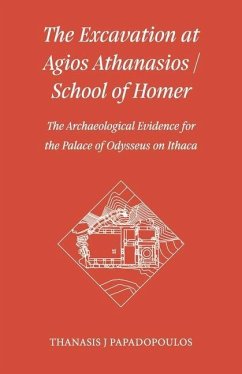The archaeological paper presented here gives the evidence for the location of the historic Palace of Odysseus on the Greek island of Ithaca. The record of this excavation has been well buried. The excavation at Agios Athanasios / School of Homer took place between 1994 and 2011. It was carried out by an archaeological team from the University of Ioannina in Central Greece under Professors Litsa Kontorli-Papadopoulou and Thanasis Papadopoulos. In various ways, and for various reasons, the results of this excavation have been concealed. In May 2016 Professor Thanasis Papadopoulos presented a paper at the 16th International Aegean Conference at the University of Ioannina with the title 'Mycenaean citadels of Western Greece: architecture, purpose and their intricate role in the local communities and their relations with the West' of which this smaller paper forms one section. His full paper was published in 2017 by Peeters of Leuven in a compendium titled 'ΕΣΠΕΡΟΣ/ HESPEROS, the Aegean seen from the West' and they have kindly given me permission to re-publish. The previous titles, both of the paper and of the publication, gave no indication of what lies within, or of its importance. Yet it is gold dust. Archaeological evidence of the historic Palace of Odysseus on Ithaca has been difficult to find. Not only the previous name of this paper but the current name of the site, Agios Athanasios / School of Homer, do nothing to help us in our search. In addition the finds at the site were deeply buried. Habitation there continued from before, during and after the time of Odysseus, through the Dark Ages, the time of Homer, the Classical period and into the Roman rule of Ithaca around the time of Christ. During some 1,200 years following Odysseus' time buildings were demolished and stones re-used. This later digging also disturbed the stratification of the ground, making it difficult for archaeologists to identify the Mycenaean remains hidden below and, as this site has been known for generations, a large amount of looting had taken place. Excavation needed patient and careful work, dedicated to the particular task of uncovering the older ruins that lay below. And this happened. Principally over the last hundred years, claims have grown up that Odysseus centred his kingdom elsewhere. Recently, along with vested interests, these claims have multiplied. The financial crisis of 2008 struck Greece hard and, in 2010, funding for further work on Ithaca was withdrawn. The excavation at Agios Athanasios was left incomplete, and in 2015 the main archaeologist Litsa Kontorli-Papadopoulou died suddenly of a stroke. At the time of her death she had not yet written up her work but fortunately, the following year, her husband Thanasis was able to do this. The correlation between the archaeological site now called Agios Athanasios / School of Homer, and the descriptions given by Homer in The Odyssey, are an extraordinarily good fit. If Professor Papadopoulos is correct the poet Homer used this very megaron (or main hall) as the setting for Odysseus' battle with 108 suitors on his return, after 20 years, from the Trojan War and for his reunion with his faithful wife Penelope. Some may disagree with Papadopoulos' conclusion that this site is that of the Palace of Odysseus described by Homer in The Odyssey. This disagreement has led to the current situation where this known Bronze Age site on Ithaca, with its obvious cultural and literary significance, has been left half-excavated, with no on-site explanation and open pits that are both dangerous and vulnerable. I hope the re-publication of this paper will serve to spread word of this situation and that it can swiftly be rectified.








